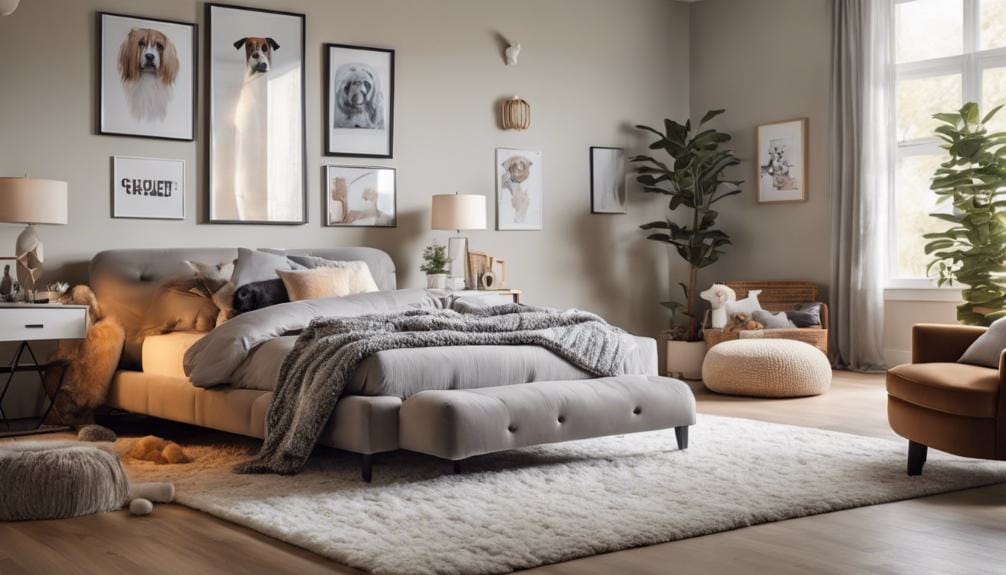If you find yourself constantly battling with a furry bed invader, you’re not alone.
The struggle of keeping your dog off the bed can be a challenging one, but fear not, there are effective strategies to help you reclaim your sleeping space.
From crate training to providing alternative cozy spots, there are various methods to explore.
Stay tuned to discover practical tips on how to maintain a dog-free sanctuary in your bedroom.
Key Takeaways
- Crate train your dog for designated sleeping areas.
- Establish clear boundaries with consistent training.
- Provide a comfortable dog bed for quality sleep.
- Engage in regular exercise and mental stimulation.
Crate Training for Dog Bed Behavior
To effectively deter your dog from getting on the bed, consider utilizing crate training as a practical method for establishing desired sleeping behaviors. Crate training provides your dog with a safe and comfortable sleeping space while confirming boundaries. By keeping the dog crated in the bedroom, you confirm proximity without allowing access to the bed, teaching them where they should sleep at night. This method helps in establishing a routine and redirecting the dog’s behavior towards a designated sleeping area, ultimately preventing them from getting on the bed.
Crate training can be particularly effective in keeping your dog off the bed while still allowing them to be close to you in the bedroom. It serves as a positive way to set boundaries and provide a structured environment for your pet. When introducing crate training, make sure to select a crate that’s appropriately sized and comfortable for your dog. Place cozy bedding and familiar toys inside to make it inviting. Gradually acclimate your dog to the crate by associating it with positive experiences and rewards. Consistency is key in crate training, so be patient and persistent in enforcing this designated sleeping area for your dog.
Establish Boundaries With Bedroom Door

By closing the bedroom door, you can effectively establish boundaries to keep your dog off the bed. This simple act helps in ensuring that your furry friend understands where they’re allowed to be, especially during sleep time. By restricting access through closed doors, you make sure your dog stays off the bed, promoting better sleep for both you and your pet. This method is an immediate and effective way to communicate to your dog that the bed is off-limits. Making sure the bedroom door is closed every time you aren’t present can aid in training your dog to keep away from the bed.
Establishing this boundary with the bedroom door is an important step in setting clear expectations for your dog regarding where they’re allowed to be. It helps in creating a consistent environment and reinforces the training you provide. By making it a habit to keep the bedroom door closed, you’re actively engaging in the training process to keep your dog off the bed. This practice also contributes to a harmonious cohabitation by respecting each other’s spaces. So, make sure the bedroom door remains closed to maintain the boundary and reinforce the message that the bed is a no-go zone for your dog.
Teach the Off Command Consistently

Consistently using the ‘off’ command when your dog attempts to get on the bed is essential in teaching them to respect the boundary. Here’s how you can effectively teach your dog to stay off your bed:
- Use Positive Reinforcement: Whenever your dog responds to the ‘off’ command and stays off the bed, reward them with treats or toys. This positive reinforcement helps reinforce the desired behavior.
- Short Training Sessions: Practice the ‘off’ command during short and frequent training sessions. This repetition will help solidify the behavior and make it more likely for your dog to comply.
- Involve Household Members: Make sure that all members of the household are aware of the training method and consistently enforce the ‘off’ command. This collective effort will help maintain consistency in keeping your dog off the bed.
- Be Patient and Persistent: Teaching your dog to stay off the bed requires patience and persistence. It may take time for your dog to fully grasp the command, so remain consistent in your training efforts.
Provide Adequate Exercise for Dog

Engage your dog in regular exercise to guarantee their physical and mental well-being. Dog owners must understand that dogs require at least 30 minutes to 2 hours of exercise every day, depending on factors like breed and age. Regular physical activity not only keeps your dog fit but also plays an important role in preventing boredom, anxiety, and destructive behavior. Activities such as walking, running, playing fetch, or engaging in agility training are excellent ways to keep your dog stimulated both physically and mentally.
In addition to physical exercise, mental stimulation is equally important for your dog’s overall well-being. Incorporating activities like puzzle toys, training sessions, or scent work can help tire out your dog effectively. Mental exercises challenge your dog’s problem-solving skills and provide a different form of stimulation.
Furthermore, ensuring your dog gets adequate exercise before bedtime can promote relaxation and better sleep, reducing the likelihood of them seeking out your bed for comfort during the night. By incorporating a mix of physical and mental activities into your dog’s routine, you can help them expend excess energy and promote a healthier sleep pattern. Training your dog through exercise not only improves their behavior but also strengthens the bond between you and your furry companion.
Invest in a Comfortable Dog Bed

For your dog to stay off your bed, making sure they have a comfortable and inviting dog bed is essential. Here are some essential tips for choosing the right dog bed:
- Size and Preference: Select a dog bed that matches your dog’s size and sleeping habits. Dogs like to stretch out or curl up, so consider these preferences when choosing the size and shape of the bed.
- Orthopedic Support: Opt for orthopedic dog beds, especially for senior dogs or breeds prone to joint issues. These beds provide extra support and comfort, promoting better joint health and overall well-being.
- Durable and Washable: Choose a dog bed made from durable materials that can withstand your dog’s activity level. Additionally, select a bed with a washable cover to make sure easy cleaning and maintenance.
- Quality Sleep and Relaxation: Investing in a cozy and inviting dog bed won’t only keep your dog off your bed but also promote quality sleep and relaxation. A comfortable bed tailored to your dog’s needs can become their favorite spot for rest and downtime.
Frequently Asked Questions
How Do I Get My Dog to Stop Laying on My Bed?
You can teach your dog to stop laying on your bed by using positive reinforcement techniques like treats and praise. Establish clear boundaries and provide a comfortable alternative sleeping spot. Engage in consistent training to assure success.
How Do I Stop My Dog From Climbing on the Bed?
To prevent your dog from climbing on the bed, establish boundaries, redirect to a designated dog bed, use positive reinforcement, consider crate training at night, establish a bedtime routine, and engage in activities to discourage bed climbing behavior.
How Can I Stop My Dog Sleeping in Bed?
To stop your dog from sleeping in bed, establish clear boundaries by providing a comfortable alternative like a designated dog bed. Use positive reinforcement methods, such as treats and praise, and consider crate training at night for consistency.
Should I Stop Letting My Dog Sleep in My Bed?
You should consider stopping letting your dog sleep in your bed due to potential health risks and sleep disturbances. Setting boundaries and providing a comfortable alternative can improve both your sleep quality and your dog’s behavior.
Conclusion
To guarantee keeping your dog off the bed requires establishing clear boundaries, consistent training, and providing alternatives.
By crate training, setting boundaries with the bedroom door, teaching the ‘off’ command, providing adequate exercise, and investing in a comfortable dog bed, you can successfully prevent your furry friend from sleeping on your bed.
Remember to be patient and consistent in your approach to guarantee a harmonious living environment for both you and your dog.





Leave a Reply
You must be logged in to post a comment.